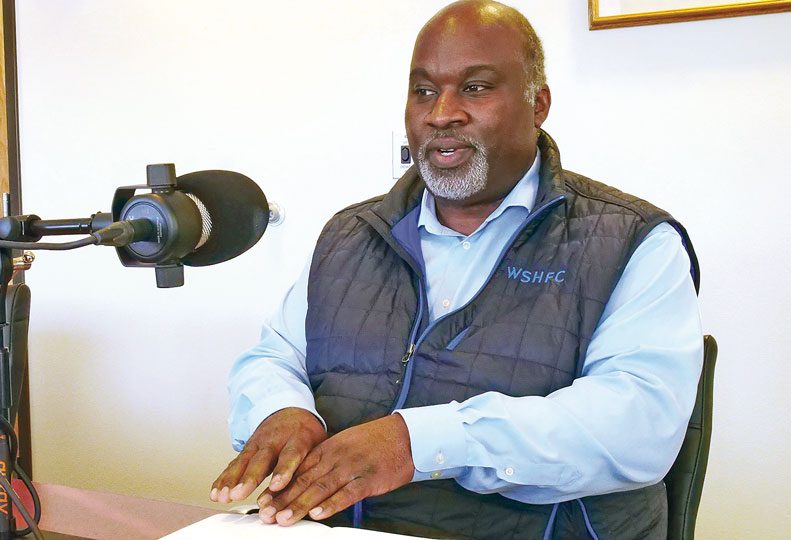
Home » Five Takeaways: West Plains Growth, Challenges & Opportunities
Five Takeaways: West Plains Growth, Challenges & Opportunities
With Albert Tripp, city manager for the city of Airway Heights

March 27, 2025
Earlier this month, the Journal of Business hosted Albert Tripp, city manager for the city of Airway Heights, for its most recent Elevating The Conversation podcast.
The Elevating The Conversation podcast is available on Apple Podcasts, Amazon Music, Spotify, and elsewhere. Search for it on any of those platforms or the Journal's website to hear the entire conversation, but for now, here are five takeaways—edited for space and clarity—from the episode, which runs just about 45 minutes.
1. Airway Heights and the West Plains are coming into their own. I can recall a time when the community really struggled to come into its own in a variety of different ways, including the provision of basic utilities and developing strategies on how we are going to not only embrace growth, but how are we gonna handle growth.
Also, just Airway Heights identity, in terms of, is it going to be going alone in all of its endeavors or seeking to be an active partner in different opportunities that emerge.
Like a lot of things, sometimes it's hard to see the forest for the trees when you're so close to it. But truly, I think we made a lot of strides in those different areas. In the area of basic utilities, we've put in place major infrastructure projects, to include water, wastewater, and transportation projects to accommodate not only the existing needs, but also planning for future opportunity.
I feel like we're now in a position in which we know who we are and what we can bring to the table.
2. Location, availability have driven growth. The West Plains has grown, and I think there are two underlying drivers for that.
The first one is access to an abundance of commercial- and light industrial-zoned land. Airway Heights, and the West Plains in general, has an abundance of it. It's one of the last few places within Spokane County with that amount of property that's available.
The second component, I believe, is that land is also adjacent to major transportation corridors, be it Interstate 90, U.S. 2, Spokane International Airport, or rail. These properties are co-located next to access to transportation.
Collectively, those two things coming together present a great opportunity for someone looking to develop a business on the West Plains. And of course, that growth and business development begets the need for people to have a place to have housing. They need to have those services to support those needs. They need to have institutions like schools to be able to support their families. And so I think it's just a domino effect.
The casinos have played a part too, hands down. The Kalispel Tribe was the tip of the spear with their project, and then followed by the Spokane Tribe. Both are located within the city limits.
With the development of each of those institutions and the uses that they developed, it really took Airway Heights from not being on the map to actually having an identity, in terms of you know a place that people can come to be entertained and receive world-class services.
They've really gone above and beyond in the way in which they've made their developments.
3. Growth Management Act update process is underway and includes new wrinkles. Airway Heights is planning in accordance with the Growth Management Act (a Washington state law that requires municipalities to plan in order to contain urban sprawl), as are the other communities within Spokane County.
There have been some new requirements with the GMA. One that stands out to me is the element around housing. Cities have always been like a facilitator of categorizing and zoning property to facilitate housing, but one of the new requirements flowing from the Growth Management Act during the most recent adoption is that cities will be required to plan housing for a range of income streams.
Market-rate housing has perhaps never been a challenge for most communities. The ability to recover the investment has always been there. But I think one of the interesting areas will be, and it is yet to be determined how this is gonna work out for a lot of communities, is the component relative to planning for low-income housing, for families that are at 60% to 80% of area median income.
Those are challenging projects in the best of times. Often, it's nonprofits relying upon state resources or some form of a federal grant in order to get those accomplished.
That isn't to say the needs aren't there. The need is clearly there, but the challenging aspect is being able to put together the funding packages for the entities that bring these products to the table and bring them to fruition.
GMA is requiring that each of the cities plan for these and not only plan for these, but they ensure that these projects are coming online within x amount of time after their comprehensive plan is adopted. It's something that we're mindful of, and we're trying to get ahead of ourselves in terms of, how do we not only plan for it, but then how do we actively support the ability to bring these projects on. And what does that look like?
By the way of background, we're in the midst of updating our plan, and it's scheduled to be completed at the end of December 2026.
4. Building permitting process is getting more efficient. One of the pinch points we're working on is in the area of permitting. That's been an area we've struggled with in the past. We've heard from our development community that it's taken too much time to be able to have a permit issued for a residential or commercial project.
And so we definitely heard that loud and clear. I think one of the struggles that we had was that the department in general was just under resourced in terms of the investment within it to be able to get the outcome that we want to.
Receiving that feedback, we made some incredible strides. We've gone from taking 90 to 120 days to issue a single-family residential permit to now issuing one within nine business days. And I feel like that's the beginning where we're gonna continue to make investment in that area in order to make sure that things are done in a very timely way so that we can facilitate commerce getting underway within our community.
5. Opportunities exist on underutilized properties in and around Airway Heights. There's definitely opportunity there. And you know, I noted earlier that part of the struggles that we had in the past was from a strategy standpoint to help navigate where we are to where we want to be.
I'm really proud of the plans we put in place to help guide that. If you look on the south of U.S. 2, there's a lot of vacant and underutilized light industrial and industrial properties. But with these strategies, they're designed in such a way to focus on the strengths that particular area provides, which are in spaces like logistics, aerospace, food manufacturing, and others.
So, they're designed to be attractive to those types of uses and then to allow for those underutilized spaces to be either used to a higher level or to greater densities than what they currently are. And we're trying to provide incentives to help move in that particular direction from a city perspective, as far as encouraging that type of use.
This interview has been edited for length and clarity.
Latest News Government Insights
Related Articles
Related Products





![Brad head shot[1] web](https://www.spokanejournal.com/ext/resources/2025/03/10/thumb/Brad-Head-Shot[1]_web.jpg?1741642753)